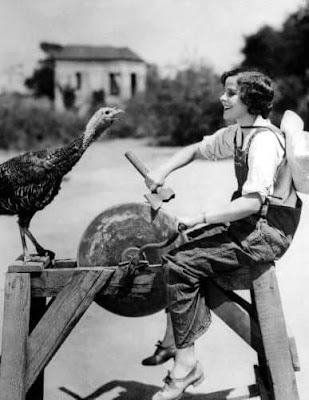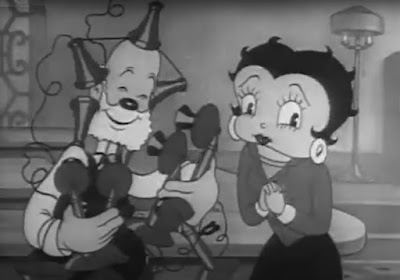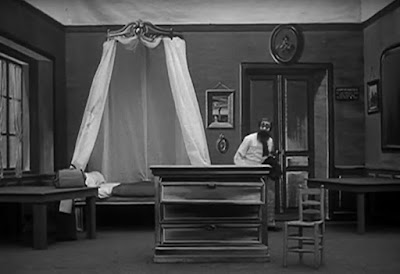Saturday, November 21, 2020
Friday, November 20, 2020
The third Fantômas film suffers from too much of a good thing
Fantômas III: The Murderous Corpse (aka "The Deadly Corpse" and "The Dead Man Who Killed") (1913)
Starring: Georges Melchior, René Navarre, Fabienne Fabrèges, Edmund Breon, Luitz-Morat, Jane Farber, Marie Dorly, Naudier, and Renée Carl
Director: Louis Feuillade
Rating: Six of Ten Stars
Fandor (Melchoir) attempts to solve the mystery of how the fingerprints of a man who died in prison are showing up at crime scenes. Meanwhile, Fantômas (Navarre) is murdering, stealing, and undertaking a stock swindling scheme, all without fear of detection now that his nemesis Inspector Juve (Breon) is missing and presumed dead.
Another issue is the return of Lady Beltham (played by Renée Carl). The character's murky relationship to Fantômas in "Juve vs Fantomas" bothered me, but here I find it downright annoying. Even Fantômas seems surprised when she turns up on his doorstep to offer her assistance in his latest schemes, putting a lie to my notion that there was some twisted romantic relationship between the characters. Perhaps viewers in 1913 understood Lady Beltham's role in the over-arcing storyline of the series--these films were based on best-selling novels of the day, so the target audience already knew all the characters and how they were connected to each other--but I was left wondering why she was brought back instead of the far more interesting new female assistant that was introduced in the previous film (and who is nowhere in this one).
I was also bothered by the fact that this film is tinted, but I went on about my issues there extensively in my write up of"Juve vs Fantomas" so I won't repeat them here.
Ultimately, "The Murderous Corpse" is a somewhat disappointing entry in the "Fantômas" series with a bunch of good components coming together to form a less-than-satisfying whole. Maybe things get better again in Part Four!
Starring: Georges Melchior, René Navarre, Fabienne Fabrèges, Edmund Breon, Luitz-Morat, Jane Farber, Marie Dorly, Naudier, and Renée Carl
Director: Louis Feuillade
Rating: Six of Ten Stars
Fandor (Melchoir) attempts to solve the mystery of how the fingerprints of a man who died in prison are showing up at crime scenes. Meanwhile, Fantômas (Navarre) is murdering, stealing, and undertaking a stock swindling scheme, all without fear of detection now that his nemesis Inspector Juve (Breon) is missing and presumed dead.
"The Deadly Corpse" is the longest Fantomas chapter so far, but it would have been better served if it had been shorter. While a few scenes are padded with characters meandering about and not much happening, the bigger problem is that the film is crammed too full of sinister Fantômas-ing.
In "The Deadly Corpse", Fantômas is basically engineering a stock manipulation scheme, but he goes about it with a ridiculously complicated web interconnected crimes--such as framing a guy for murder and then murdering him (as well as stealing his dead body), a jewel heist and some related extortion, and a second murder (for which he frames the missing dead man). All of these things are excellent ideas and very well presented in the film... but these good pieces add up to a less than satisfying whole. This would have been a much stronger film (not to mention shorter) if Fantômas had just done the heist and the second murder, or perhaps skipped the heist and just used the mystery of the how a dead man of the first kill could be committing murder to sensationalize the second the kill. Maybe my reaction is coming from being 100+ years of development of cinematic thriller tropes removed from this film, or maybe this film is a prime example of "too much of a good thing."
Another issue is the return of Lady Beltham (played by Renée Carl). The character's murky relationship to Fantômas in "Juve vs Fantomas" bothered me, but here I find it downright annoying. Even Fantômas seems surprised when she turns up on his doorstep to offer her assistance in his latest schemes, putting a lie to my notion that there was some twisted romantic relationship between the characters. Perhaps viewers in 1913 understood Lady Beltham's role in the over-arcing storyline of the series--these films were based on best-selling novels of the day, so the target audience already knew all the characters and how they were connected to each other--but I was left wondering why she was brought back instead of the far more interesting new female assistant that was introduced in the previous film (and who is nowhere in this one).
I was also bothered by the fact that this film is tinted, but I went on about my issues there extensively in my write up of"Juve vs Fantomas" so I won't repeat them here.
Ultimately, "The Murderous Corpse" is a somewhat disappointing entry in the "Fantômas" series with a bunch of good components coming together to form a less-than-satisfying whole. Maybe things get better again in Part Four!
Thursday, November 19, 2020
Barbara Kent is getting ready...
... for a Socially Distanced Thankgiving dinner at Shade of Gray's end-of-the-world survival bunker-equipped hideaway. How about you?
Betty and Grampy deliver 'Service With a Smile'
Service With a Smile (1937)
Starring: Mae Questel (Voice of Betty Boop) and Jack Mercer (Voice of Grampy)
Directors: Dave Fleischer and Dave Tendlar
Rating: Seven of Ten Stars
It's the grand opening of the Hi-Di-Ho-Tel. Front desk clerk Betty is getting overwhelmed with demands from angry guests... until Grampy saves the day with his brilliant mind and talent for make-shift mechanical engineering.
In "Service With a Smile", Betty Boop is once again relegated to second billing in her own series, and genial mechanical genius Grampy and his creations take center stage, drive most of the story, and ultimately save the day. He elevates the service provided to guests with legitimate complaints to wondrous levels while delivering well-deserved comeuppance to those who are just obnoxious.
Among the high points in this Betty Boop outing are some nice (and sometimes subtle) callbacks to some of the older entries in the series, with the name of the hotel being foremost among these. There's none of the surrealism or edgy humor that was present in those efforts from the early 1930s, but the steady stream of good-natured gags (which start with the signs outside the hotel in the opening scene and don't stop until the closing fade-out) and the assortment of odd and/or troublesome guests at the hotel manage to make this a bit of fast-paced, fun entertainment.
Since we here at Shades of Gray also like to provide service with a smile, we invite you to check out "Service With a Smile" right now, by clicking below. It's only about seven minutes long, and we promise it will brighten your day!
Wednesday, November 18, 2020
The Swank Quarterly
In 1999, shortly before her star shot to full ascendancy with her Oscar-winning role in "Boys Don't Cry", Hilary Swank sat for portraits with photographer Rick McGinnis. (And that is literal... she sat on the floor in a hotel hallway where a film festival was taking place.)
For more pictures from this series, as well as extensive comments from McGinnis about the circumstances under which it came to pass, click here.
For more pictures from this series, as well as extensive comments from McGinnis about the circumstances under which it came to pass, click here.
Tuesday, November 17, 2020
'The Black Imp' brings special effects fun
The Black Imp (1905)
Starring: Georges Melies
Director: Georges Melies
Rating: Eight of Ten Stars
A traveler rents a room already inhabited by a playful demon. It turns out that there truly is no rest for the wicked, as the imp does not appreciate having a roommate.
"The Black Imp" shares many similar elements as "The Apparition", which was made and released in 1903. First, both have hotel guests who is tormented by a supernatural being. Second, said victims are deserving of the torment, because they both sexually harasses the hotel maid. Third, both guests at first seem unfazed by objects and people teleporting about, transforming and appearing or disappearing in the room. (As I said in my review of "The Apparition", France of early 20th century must have been a very different place than it is today.)
All in all, "The Black Imp" feels like a remake of "The Apparition", with Melies applying lessons learned since 1903 and getting more elaborate with the stop-motion effects and other trick photography methods. Comparing the two films is interesting, as well as fun, as they are near-plotless vehicles for showing off Melies' exploration of cinematic magic--and the joy of creation and discovery of special effects techniques is palpable.
Once "The Black Imp" gets going, it's a non-stop sequence of rapid-fire effect shots, including a very impressive bit where the hotel guest suddenly finds himself in midair and then plummets to the floor. The effects are so seamless that I wonder how Melies pulled it off... and it made me wonder why he didn't use a similar technique in later films to, for example cause the Moon Maiden in "The Dream of an Opium Fiend" (1908), Having the Moon Maiden float from her perch to the floor instead of using a step ladder would have been much more impressive.
I've embedded "The Black Imp" below. If you have five minutes, you should check it out. The acting is a bit hammy (to put it mildly) but even though it's 115 years old, it's lots of fun and the special effects are impressive.
Monday, November 16, 2020
Baby Yoda vs. the Cunts of Guns N Roses
Like the Galactic Empire and the various warlords left in its wake, the Cunts of Guns N Roses Music are on the hunt for Baby Yoda!

On or about November 5, the comedy group Merkins posted a collaboration with a Guns N Roses coverband that was part spoof of the hit song "Sweet Child of Mine" and part tribute to the very popular Star Wars series on Disney+, "The Mandalorian".
Completely lacking a sense of humor and/or appreciation for the rules surrounding parodies, Guns N Roses Music filed a copyright claim against the video and YouTube took it down. With the ruthless efficiency of a Moff and his Stormtroopers, Guns N Roses Music tried to destroy Baby Yoda. This was on or about November 9. They failed to destroy the Child, but they are still hunting for him.
Their most recent assassination attempt took place on about November 15. Here's a screen shot of the aftermath:

Like the Mighty Mando, we're devoted to the safety the Child. We will celebrate every time he survives an attack by embedding yet another upload of "Green Child of Mine" into this post. We'll keep doing this over and over and over... until the Cunts of Guns and Roses defeat Baby Yoda, or we get bored. (Click here if you want to see the original Musical Monday post.)
May the Force be with you. Always.

On or about November 5, the comedy group Merkins posted a collaboration with a Guns N Roses coverband that was part spoof of the hit song "Sweet Child of Mine" and part tribute to the very popular Star Wars series on Disney+, "The Mandalorian".
Completely lacking a sense of humor and/or appreciation for the rules surrounding parodies, Guns N Roses Music filed a copyright claim against the video and YouTube took it down. With the ruthless efficiency of a Moff and his Stormtroopers, Guns N Roses Music tried to destroy Baby Yoda. This was on or about November 9. They failed to destroy the Child, but they are still hunting for him.
Their most recent assassination attempt took place on about November 15. Here's a screen shot of the aftermath:

But, once again, Baby Yoda survived and "Green Child of Mine" is still available for everyone to enjoy and be amused by. In fact, it's embedded right below!
On or about November 23, the Cunts of Guns N Roses made another attempt to murder Baby Yoda. But, as shown here, he survived again and Guns N Helmets are here to celebrate!
On or about November 22, 2020, the Cunts of Guns N Roses tried to kill Baby Yoda again. So we linked to another upload of the "Green Child of Mine" video.
Like the Mighty Mando, we're devoted to the safety the Child. We will celebrate every time he survives an attack by embedding yet another upload of "Green Child of Mine" into this post. We'll keep doing this over and over and over... until the Cunts of Guns and Roses defeat Baby Yoda, or we get bored. (Click here if you want to see the original Musical Monday post.)
May the Force be with you. Always.
Musical Monday with Edwyn Collins
Edwyn Collins is a Scottish singer and guitarist who's been performing with bands or as a solo act since the early 1980s. "A Girl Like You" was a worldwide hit in 1994, and if you missed it back then, check it out now, because it's a song that's held up beautifully.
Further, the video is one that must be seen, especially by fans of 1960s dance styles and James Bond movies prior to the dawn of the 2000s. (I can't say much more without ruining the surprises, but I think regular visitors to this blog will find this Monday's selection a good way to start the week!)
Sunday, November 15, 2020
Tom and Jerry are in a 'Jungle Jam'
Jungle Jam (1932)
Starring: Unknown Voice Actors (although spoken lines are minimal)
Directors: John Foster and George Rufle
Rating: Six of Ten Stars
Tom and Jerry are jungle explorers who run afoul a village of hostile cannibals.
"Jungle Jam" joins Tom & Jerry installments like "The Tuba Tooter" and "Pots and Pans" as a nearly plot-free mini-musical where the song and dance numbers are loosely connected by scenes of featuring gags and a varying degree of surreal nonsense. Some of the gags featured here will be refined and repeated in "Redskin Blues", as well the theme of our heroes being captured by a hostile tribe. In addition to the improved "second take" on gags, "Redskin Blues" has a little more story than what we get here.
Although "Jungle Jam" ends up being an average entry in the Tom & Jerry episode, it opens strong, with one of the cutest sequences in the entire series involving our heroes in a canoe, crocodiles, and dancing monkeys. The cartoon remains amusing throughout, but it never quite reaches the level of the opening musical number. (In fact, it comes dangerously close to nose-diving into pure awfulness when Jerry sometime capricious and stupid and our heroes could easily escape the danger of cannibals by simply running away. If you've watched any Tom & Jerry cartoons, you probably know that "capricious and stupid" are pretty much standard, but what happens here is beyond the Pale.)
One thing I should mention in this day and age of people being overly sensitive and/or looking for reasons to be offended is that there's a fair amount of ethnic and racial humor in the second half of "Jungle Jam". Again, this is something that anyone who's seen more than a couple installments in this series will expect, the content here may easily draw cries of racism and racist portrayals (if the mention of cannibals at the top, or the screen-shot illustrating this article, didn't make it clear). I don't think that's completely accurate though, although I understand the impulse; the character designs of the tribesmen aren't that different from that of Jerry, and even Tom in some of the cartoons. Is there racial and ethnic mockery and stereotyping here--yes. Is it racist--I don't think so.
But--why don't you check out "Jungle Jam for yourself? There are worse ways to spend a few minutes--and certainly ones that are far less amusing!
For a detailed history of the Van Beuren Company and more background on the development of Milton discussed above, you should get a copy of Hal Erickson's very detailed, yet entertaining, book "A Van Beuren Production".
Subscribe to:
Posts (Atom)






































.jpg)
